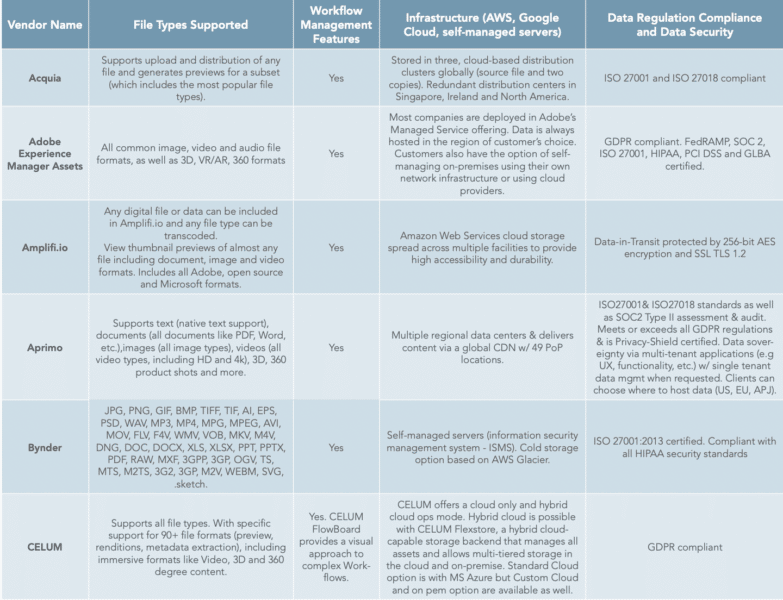
Digital asset management can play a vital role in your marketing organization, unifying online and offline marketing channels and leading to more efficient marketing resource allocation.
Given all of that promise, marketers are certainly evaluating these technologies and one crucial part of that process is the demo.
It’s important to set up demos within a relatively short time frame of each other to help make relevant
comparisons. Also, make sure that all potential internal users are on the demo call, and pay attention to the following:
- How easy is the platform to use?
- Does the vendor seem to understand our business and our marketing needs?
- Are they showing us our “must-have” features?

Explore DAM solutions from vendors like Acquia, Widen, Cloudinary, MediaValet and more in the full MarTech Intelligence Report on digital asset management platforms.
Use the following 20 questions to help you gauge whether the platforms you are sampling are right for your organizations:
File types
- What file types do you support, meaning users can view thumbnails and also convert those files into other formats as needed?
- What file types can be uploaded and downloaded, but aren’t officially supported?
Integrations
- Do you offer native, off-the-shelf integrations with third-party systems such as web content management, mobile apps, marketing automation platforms, etc.? If so, which ones?
- Are APIs available? Is access included in the pricing?
Infrastructure and onboarding
- What makes this platform technically unique from all the others?
- How difficult is the platform set up and implementation? How long will it take for us to be up and running on the system?
- How intuitive is the platform user interface? How easy is it for business users to customize the machine learning-based models or settings?
- What is your service reliability guarantee?
- Do you host the content yourself or who do you work with for hosting capabilities?
- How scalable is the platform? How much data can it handle in terms of file size and simultaneous interactions across a wide geographic area?
Get the daily newsletter digital marketers rely on.
Pricing and support
- What is pricing based on? What features are included? Are there additional fees (consulting, add-on features, APIs, quotas)?
- What is the minimum contract length? Is there a short-term contract or an “out” clause if things don’t work out?
- Is a free trial or pilot program available?
- Can your platform be white-labeled for agencies or multi-location marketers?
- Who will be the day-to-day contact?
- Who pays if your system/team makes an error?
- What kind of customer support is available? Can I pick up the phone to report problems?
Strategy and product roadmap
- Do you have other clients in my vertical?
- How does the company handle requests for product modifications?
- What new features are you considering? What’s the long-term roadmap and launch dates?
Digital asset management platforms: A snapshot
What is it? Anyone who’s struggled to find a file on their computer or shared drive understands the pain of tracking down content. And when you consider the sheer amount of files you need to sort through when many versions are created to resonate with specific audiences, these tasks can feel overwhelming. Digital asset management platforms simplify these tasks by bringing all of your marketing content together.
Why are they important? Marketers are creating engaging content for more channels than ever before, which means the software used to manage these assets is gaining importance. What’s more, the communications between businesses and their customers are increasingly digital. Marketing content today is created in a wide variety of formats and distributed wherever consumers are digitally connected.
Why now? More than half of 1,000 consumers recently surveyed said they’re more likely to make a purchase if brand content is personalized, according to the Adobe Consumer Content Survey. Digital asset management platforms help marketers implement these personalization tactics. They also provide valuable insights into content interaction and the effectiveness of their assets.
Why we care. When those creating and using content aren’t near one another, having a central repository for assets is helpful. Finding the right content for your audience is made simpler when each version is organized in the same location. For these reasons and more, your marketing operations could benefit from adopting a digital asset management system.





